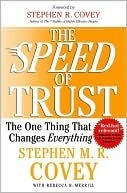More on this book
Community
Kindle Notes & Highlights
Read between
December 29, 2022 - April 25, 2023
We can increase trust—much faster than we might think—and doing so will have a huge impact, both in the quality of our lives and in the results we’re able to achieve.
Simply put, trust means confidence. The opposite of trust—distrust—is suspicion.
In a high-trust relationship, you can say the wrong thing, and people will still get your meaning. In a low-trust relationship, you can be very measured, even precise, and they’ll still misinterpret you.
The problem was that I had assumed far too much.
failed to focus on establishing trust with the newly merged company, believing that my reputation and credibility would already be known.
The moment there is suspicion about a person’s motives, everything he does becomes tainted.
the real test, however, would be on how I followed through.
First, I learned that I had assumed way too much.
It breeds suspicion and cynicism, which become self-perpetuating, resulting in a costly, downward cycle.
The number one reason people leave their jobs is a bad relationship with their boss.
How does it make you feel to know that there’s more than a 50% chance that the doctor who’s going to perform surgery on you cheated in school? Or a 75% chance that the company you’re going to work for is being led by someone who didn’t consider honesty important?
76% of MBAs were willing to understate expenses that cut into their profits,
Trust always affects two outcomes—speed and cost. When trust goes down, speed will also go down and costs will go up.
(Strategy times Execution equals Results)
([Strategy times Execution] multiplied by Trust equals Results)
Stewardship means ‘a job with a trust.’ I trust you to do the job, to get it done.”
What I remember most about this experience was simply this: I felt trusted!
Few things can help an individual more than to place responsibility on him, and to let him know that you trust him.
to think that trust is based on character only is a myth.
Trust is a function of two things: character and competence. Character includes your integrity, your motive, your intent with people. Competence includes your capabilities, your skills, your results, your track record.
consistently emphasizing the importance of both character and competence as vital to sustained success and leadership.
“If you think the problem is out there, that very thought is the problem.”
the “5 Waves of Trust.” This model derives from the “ripple effect” metaphor that graphically illustrates the interdependent nature of trust and how it flows from the inside out.
THE FIRST WAVE: SELF TRUST
Self Trust, deals with the confidence we have in ourselves—in our ability to set and achieve goals, to keep commitments, to walk our talk—and also with our ability to inspire trust in others.
THE SECOND WAVE: RELATIONSHIP TRUST
The key principle underlying this wave is consistent behavior,
THE THIRD WAVE: ORGANIZATIONAL TRUST
deals with how leaders can generate trust in all kinds of organizations, including businesses, not-for-profit organizations, government entities, educational institutions, and families, as well as in teams and other microunits within organizations.
THE FOURTH WAVE: MARKET TRUST
The underlying principle behind this wave is reputation. It’s about your company brand (as well as your personal brand), which reflects the trust customers, investors, and others in the marketplace have in you.
THE FIFTH WAVE: SOCIETAL TRUST
about creating value for others
The principle underlying this wave is contribution. By contributing or “giving back,” we counteract the suspicion, cynicism, and low-trus...
This highlight has been truncated due to consecutive passage length restrictions.
Yesterday I was clever, so I wanted to change the world. Today I am wise, so I am changing myself.
it is possible not only to build trust, but also to restore it.
Tom went in with the intent to genuinely seek to understand Chris’ point of view. He listened. He verbally reflected back his understanding of what Chris was saying. Once Chris felt understood, he was willing to listen to Tom.
I forgive all my enemies and hope they may find mercy in Heaven.
Adams and Jefferson enjoyed a rich and satisfying friendship and correspondence for fourteen years before they both passed away, amazingly, on the same day: the Fourth of July, 1826, the fiftieth anniversary of the American Declaration of Independence. Among Adams’ most memorable words to Jefferson were these: “While I breathe, I shall be your friend.”
You can’t talk yourself out of a problem you’ve behaved yourself into.
People don’t listen to you speak; they watch your feet.
People may listen to what you say but they will believe what you do.


